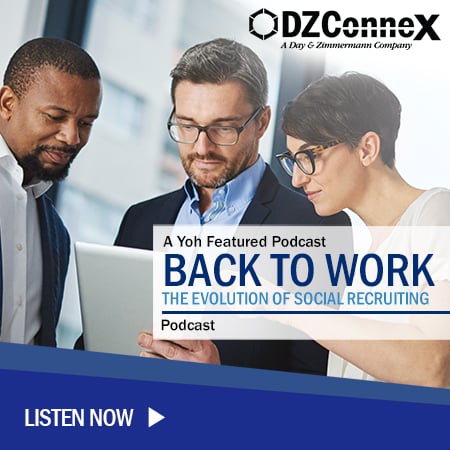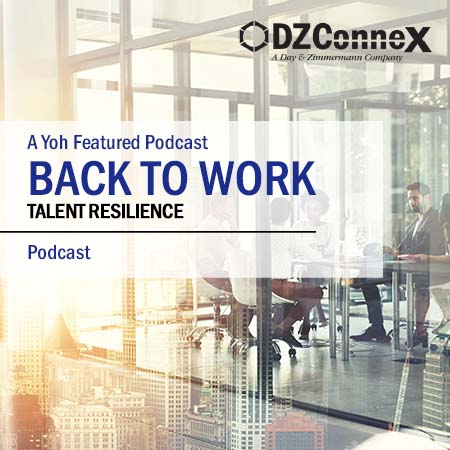Social recruiting is not a new tool being used in the staffing industry, but it has evolved into an essential talent acquisition tool within the past few years. It is the process of recruiting candidates through social media platforms, online forums, digital job boards, blogs, etc. Talent acquisition is long past the old days of just placing a job ad at a local coffee shop. As our world has become more reliant on the Internet, companies have had to focus on building their online brand and engaging with their potential talent pool through the various digital channels available to them.
In this episode of our Back to Work podcast series, our host, Joe McIntyre, and Yoh's Senior Business Development Manager, Michelle Sohl, explore the impact of social recruiting in the staffing industry and share best practices for organizations looking to develop a social recruiting strategy.
Listen to our Podcast:
Pros and Cons of Social Recruiting
Utilizing social media for talent acquisition has advantages and disadvantages for both companies and candidates. For companies, social recruiting has made recruiters' jobs easier in some ways and more difficult in others. It is advantageous to organizations because of the ability to reach such a large audience online, giving them access to a larger talent pool than ever before. Additionally, it's a cost-effective recruitment method. Posting on social platforms typically does not cost money, so social recruiting can save organizations a significant amount.
The biggest drawback for organizations using social recruiting is the possibility of not reaching your intended audience. You might post a job ad that never reaches the right candidates for some reason, so it can be a wasted effort if you don't understand how to target the right people. Furthermore, since so many people are able to view job listings, recruiters might receive thousands of applications for a position - and the majority of these candidates are not qualified for it. Sorting through these can be overwhelming, time-consuming, and inefficient for recruiters.
In the podcast, Michelle also addresses the impact of social recruiting on job seekers. Candidates can benefit from the fact that they have instant-apply access to so many job listings from around the world. There is also a downside to this, however. Users can see how many people have applied to a job posting on certain social media platforms, and the number of applicants can often be daunting. Candidates might see an intimidating number of people have already applied and decide that it's not worth it for them to try. Michelle suggests that candidates should still apply if they believe they are qualified because you should never count yourself out of something unless you try it.
Best Practices for Organizations Using Social Recruiting
Organizations need to have a solid social recruiting strategy mapped out in order to be successful. Throughout the podcast, Joe and Michelle explore some best practices for companies looking to develop a social strategy. They suggest companies start by doing their research to uncover which platforms their audience will be using the most, and focus on leveraging these channels to reach their audience. They also need to decide what information to include in their job posts to ensure they are attracting the best candidates and weeding out the underqualified and overqualified ones.
Another best practice that companies should consider embracing is pay transparency. When today's job seekers see a position posted, they expect a salary range to be present. If a listing does not include insight into the compensation, many candidates will simply move on to avoid wasting their time. People deserve to know what they can expect be paid in a given role, and this transparency can also help weed out some applicants that would not be the right fit for a job.
Michelle also points out that organizations should not underestimate the power of tracking analytics. Whoever is in charge of posting on the company's social platforms also needs to be tracking relevant analytics to learn what is performing well and what isn't. Companies can adapt their strategy to ensure they are getting the best return once they have this information available.
Some other best practices they suggest include:
- Consider putting money behind certain social posts that you want to perform better than they would organically.
- Be sure to follow up will all applicants whether they are fit for the position or not.
- Post more than just job ads on social; you should also post about company culture, events, DE&I initiatives, awards, industry news, etc.
Incorporating these components into your social recruiting strategy will set you ahead of the competition and bring the best candidates to your workforce.
To close out the podcast, they discuss how they think social recruiting will continue to evolve as technology's capabilities advance further. For more expert insights, listen to the full podcast here.







